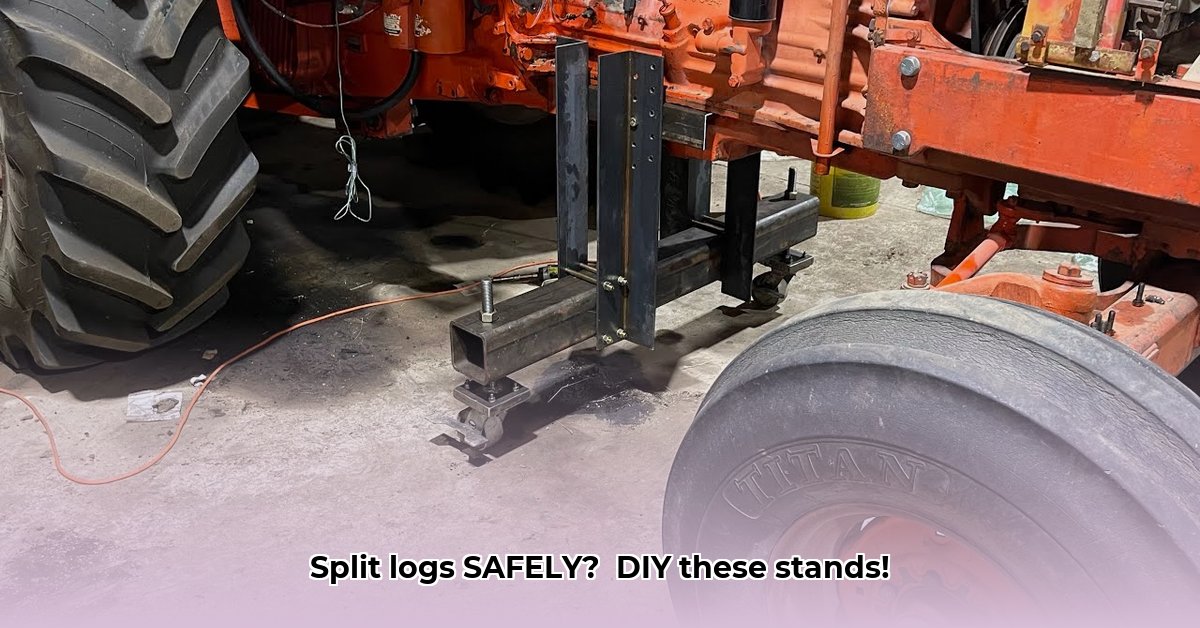
Taking your tractor apart for repairs can be expensive and intimidating. But building your own splitting stands is entirely doable, saving you money and offering a rewarding sense of accomplishment. This guide provides step-by-step instructions for several designs, catering to various skill levels and budgets. We'll emphasize safety throughout, ensuring you're prepared to safely split your tractor for repairs.
Sizing Up the Situation: Choosing the Right Stand for Your Tractor
Before you begin, carefully assess your tractor's specifications. Its size and weight are crucial in determining the appropriate stand design. A small tractor might only need simple jack stands, while a larger one requires a more substantial structure. Consider these factors:
- Tractor Weight: This dictates the minimum weight capacity required for your stands. Always choose stands with a safety margin far exceeding your tractor's weight. (A good rule of thumb is to double or even triple the tractor's weight capacity).
- Lift Points: Consult your owner's manual to identify the designated lift points on your tractor. Using incorrect lift points can damage your tractor.
- Available Tools: Your tool collection will influence the complexity of the stand you can build. Simple designs require basic hand tools, while more advanced designs may need welding equipment.
- DIY Skill Level: Be honest about your abilities. Start with a simpler design if you're a beginner and gradually progress to more complex builds as your confidence grows.
Three Homemade Stand Designs: From Simple to Advanced
We'll explore three stand designs to suit different skill levels and tractor sizes. Remember, prioritize safety above all else!
Option 1: The "Easy Peasy" Jack Stand Method (For Smaller Tractors)
This method is perfect for smaller, lighter tractors. You'll need heavy-duty jack stands and sturdy base supports (e.g., railroad ties or large, thick timbers).
- Strategic Placement: Position the jack stands securely under the designated lift points of your tractor. Ensure they're firmly placed on level ground.
- Gentle Lift: Use appropriate jacks to slowly lift your tractor. Work slowly and methodically for stability.
- Level and Secure: Once lifted, double-check that your tractor is level and the jack stands are stable. Any wobbling is unacceptable. Adjust as necessary.
Option 2: The "Adjustable Ace" Stand (For Medium-Sized Tractors)
This design offers greater adjustability, ideal for medium-sized tractors. You'll need strong lumber (pressure-treated is recommended) or steel framing and heavy-duty jacks.
- Build a Frame: Construct a sturdy frame using the chosen material. The frame should be significantly stronger than needed to support the weight of your tractor.
- Add Adjustability: Incorporate adjustable supports (threaded rods or similar mechanisms) to fine-tune the height and perfect the level of your tractor.
- Lift and Level: Position the frame, lift the tractor carefully, and use the adjustable supports to achieve precise leveling.
Option 3: The "Heavy Hitter" Chain Hoist System (For Large Tractors)
This sophisticated approach is best for large, heavy tractors and requires a sturdy overhead support structure. This requires experience with heavier equipment and lifting techniques.
- Secure the Hoist: Very securely attach a chain hoist to a reliable overhead support. This is critical for safety.
- Attach the Slings: Use heavy-duty chain slings, attaching them securely to your tractor's lift points.
- Controlled Lift: Carefully lift the tractor using the chain hoist. Slow and steady is key.
- Support and Lower: Once lifted, position supporting structures under the tractor, then slowly lower it onto these supports using the chain hoist.
Safety First: Your Personal Protective Equipment (PPE) Checklist
Working with heavy machinery demands strict adherence to safety protocols. Never compromise on safety.
- Buddy System: Always have a helper with you for spotting and assistance.
- Rated Equipment: Only use jack stands and lifting equipment with weight capacities substantially exceeding your tractor's weight.
- Wheel Chocks: Secure the tractor's wheels with wheel chocks to prevent accidental movement.
- Protective Gear: Wear safety glasses, gloves, and sturdy work boots at all times.
- Well-Lit Workspace: Ensure ample lighting to minimize accidents.
Choosing Your Lifting Equipment: Jack Stands and Jacks
The quality of your lifting equipment is paramount. Consider these factors:
- Weight Capacity: Select equipment rated for significantly more weight than your tractor. A safety margin is non-negotiable.
- Stability: Choose equipment with a wide, stable base to minimize the risk of tipping.
- Condition: Only use equipment in perfect working order. Discard any damaged or worn equipment immediately.
Troubleshooting: When Things Don’t Go as Planned
Even with careful planning, problems can arise. Here are some common issues and their solutions:
| Problem | Possible Cause | Solution |
|---|---|---|
| Uneven Lifting | Uneven weight distribution, faulty supports | Adjust supports, replace faulty parts. |
| Jack Failure | Overloading, faulty jacks | Use higher-capacity jacks; replace damaged jacks. |
| Frame Instability | Insufficiently strong frame materials | Use heavier-duty materials, reinforce the frame. |
| Tractor Slipping | Insufficient support points | Add more supports to evenly distribute weight. |
Building your own tractor splitting stands is a valuable skill. By following these instructions and prioritizing safety, you'll confidently handle this task, saving money and gaining valuable experience. Remember to always consult your tractor's manual for specific lift point locations and safety guidelines.